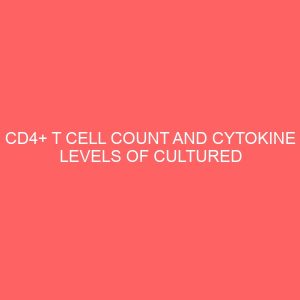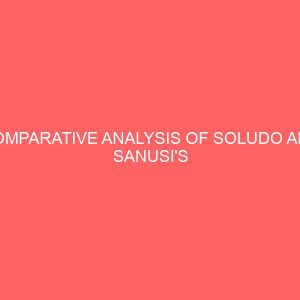Description
ABSTRACT
Tuberculosis TB is a chronic infectious disease which causes morbidity and mortality globally, but the highest death rate is reported in subSaharan African region. Unfortunately, this sub Saharan region is ravaged by malaria and Human Immunodeficiency Virus/Acquired Immunodeficiency Diseases HIV/AIDS. Coinfection with these diseases has led to the TB/HIV/malaria syndemic. This study was designed to determine the CD4 T cell counts and supernatant cytokine levels of stimulated lymphocytes isolated from pulmonary TB/HIV/malaria infected subjects. A total of two hundred and thirtyone 231 subjects male135, female96 aged between 12 and 68 years participated in the study. The subjects were classified into six groups; untreated TB positive subjects n41, TB positive subjects on antiTB drugs n65, TB and HIV positive subjects n37, TB and MP positive subjects n23, latent TB positive subjects n30 and apparently healthy control subjects n35. Sputum and blood samples were obtained from the participants. The sputum samples were used for the detection of Mycobacterium bacilli using acid fast bacilli test and by real time polymerase chain reaction using the GeneXpert MTB/RIF assay. Blood samples were used for malaria screening, malaria parasite density, CD4 T cell counts by flow cytometry, and for in vitro mononuclear cell culture for harvesting the cytokines interferon gamma IFN, tumour necrosis factor alpha TNF, interleukin 2 IL2, interleukin 4 IL4 and interleukin 10 IL10, while the serum component were used for interleukin 6 IL6, total protein, albumin and HIV screening. Cytokines levels were estimated by enzyme linked immunosorbent assay. The cytokine levels pg/ml showed that IFNand TNF were significantly higher in all the test groups compared with the control group Plt;0.05. Similarly, the IL10 was significantly higher in all test groups except latent TB positive while IL6 were significantly higher in all test groups except TB and HIV positive subjects compared with the control group Plt;0.05. The IL2 was significantly lower in the TB positive subjects on drugs and in TB and HIV positive subjects compared with the control group. IL4 was significantly lower in all test groups except in the TB and MP positive group compared with the control group Plt;0.05. However, the IFN and IL2 were significantly lower while IL 10 and IL6 were significantly higher in the TB positive subjects on TB drugs compared with latent TB positive subjects Plt;0.05. Furthermore, IFNand TNF were significantly lower while IL10 and IL6 were significantly higher in untreated TB positive subjects compared to latent TB positive subjects Plt;0.05. The CD4 T cell counts were significantly lower in the test groups except in latent TB positive group compared with the control group Plt;0.05. The findings of this study showed that there was impaired cell mediated immunity CMI in pulmonary tuberculosis. The findings suggested that coinfection with malaria does not exacerbate the impairment of cell mediated immunity but conferred immunologic protection against severe malaria. Findings also revealed that the impairment of CMI seen in HIV infected participants is not due to loss of cytokine production function but due to depletion of CD4 T cell numbers. The higher inflammatory cytokines seen in latent TB is an evidence of protection while higher antiinflammatory and regulatory cytokines in other TB test subjects is an indication of failure of protection. The implication is that there seems to be a switch in the pattern of cytokine production in clinical states of TB infection. This is because at this level of the disease, it is expected that inflammatory cytokines should be higher. In conclusion, TB disease is associated with higher antiinflammatory and regulatory cytokines while latent TB is associated with higher inflammatory cytokine levels. This might be the molecular mechanism for progression from latent to TB disease state.
TABLE OF CONTENTS
PAGE
Title pagei
Certificationii
Approval pageiii
Dedicationiv
Acknowledgementv
Table of contentsvii
List of figures xi
List of Tablesxii
List of abbreviations and acronymsxiii
Abstractxv
CHAPTER ONE: INTRODUCTION
11 Background of the study1
12 Statement of the problem3
13 Significance of the study4
14 Aim and Objectives 4
CHAPTER TWO: LITERATURE REVIEW
21 History of Tuberculosis6
22 Epidemiology of Tuberculosis7
23Transmission of Mycobacterium tuberculosis8
24 Pathogenesis of Tuberculosis10
25 Clinical Manifestations of Tuberculosis12
26 Latent Tuberculosis Infection23
27 Host Immune mechanisms in Tuberculosis26
28 Failure of the granuloma to contain Tuberculosis Infection32
29 Immunology of Tuberculosis33
210 Risk factors for Tuberculosis46
211 Tuberculosis in infants and children 47
212 Tuberculosis in pregnancy48
213 HIV and Tuberculosis50
214 Tuberculosis and Malaria57
215 Diagnosis of Tuberculosis59
216 Diagnosis of latent tuberculosis infection67
217 Classification of persons exposed/infected with M tuberculosis70
218 Treatment of tuberculosis71
219 Treatment of latent TB infection73
220 Treatment of MDR and XDR Tuberculosis73
221 New vaccine strategies against TB74
CHAPTER THREE: SUBJECTS, MATERIALS AND METHODS
31 Subjects75
32 Methods77
33 Test Methods78
331 ZiehlNeelsen ZN smears to detect AFB78
332 Fluorescent microscopy method for AFB79
333 GeneXpert Method for detection of M tuberculosis81
334 Mantoux test83
335 Detection of antibodies to HIV1/284
336 Diagnosis of Malaria86
337 Procedure for parasite count89
338 Total protein estimation90
339 Albumin estimation91
3310 Globulin calculation92
3311 Body mass index 92
3312 CD4 T cell counts93
3313 Packed cell volume94
3314 Total white cell count95
3315 Differential white cell count95
3316 Isolation of peripheral blood mononuclear cells PBMCs96
3317 Lymphocyte viability test97
3318 Cytokine estimation in supernatants and serum98
34 Statistical method105
CHAPTER FOUR: RESULTS
40 Results107
CHAPTER FIVE: DISCUSSION AND CONCLUSION
51 Discussion145
52 Conclusion168
53 Recommendation for further studies171
REFERENCES173
APPENDIX206








Reviews
There are no reviews yet.